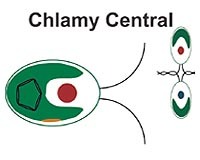
|
| ©Unknown |
| Chlamydomonas reinhardtii, known affectionately as "Chlamy," is an ancestor of plants and animals that retains characteristics of both. |
The organism, Chlamydomonas reinhardtii, known affectionately as "Chlamy," has long fascinated scientists because it is an ancestor of plants and animals that retains characteristics of both. Like green plants, Chlamy (a type of green alga) uses photosynthesis to convert solar energy and carbon dioxide into biomass. And like many animal cells, including human sperm, it has flagella that allow it to swim.
Analysis of the 15,000 genes that make up Chlamy's genome revealed hundreds that control photosynthesis and the function of flagella. The genome also provides a glimpse back through time to when all plants and animals were unicellular and used flagella to swim. When they became multicellular, plants put down roots and lost their flagella while animals retained flagella on certain kinds of cells, including sperm and cilia on some cells in the lungs, kidneys and eyes.
Led by the U.S. Department of Energy's Joint Genome Institute, the University of California and the Carnegie Institute, the genome study is published in the Oct. 12 issue of Science.
Peter Lefebvre, Carolyn Silflow and Anton Sanderfoot, members of the department of plant biology faculty, were part of the national team of researchers that carried out the massive project. LeFebvre provided the DNA sample that launched the effort and Carolyn Silflow contributed a detailed molecular map that helped the team identify the function of hundreds of genes involved in photosynthesis and the formation of flagella. Students in the College of Biological Sciences also took part in the historic research.
"We expect the work to produce new biological strategies for capturing solar energy, assimilating carbon and removing toxins from soil," said Pete Lefebvre, professor of plant biology in the College of Biological Sciences. The genome also holds clues to human diseases that result from defects in flagella and cilia. These include dyskinesia, a neurological movement disorder, and polycystic kidney disease.



Reader Comments
to our Newsletter